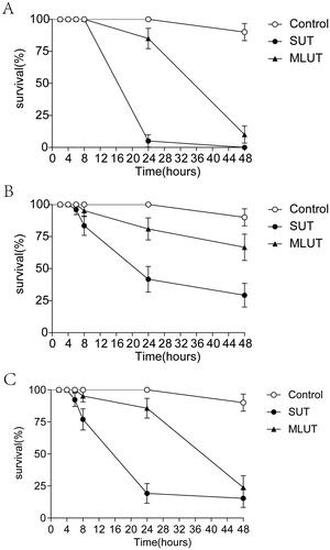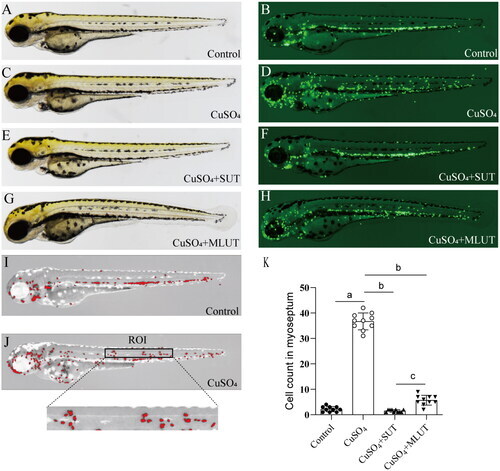- Title
-
Development of a convenient and rapid screening zebrafish model to investigate lethal effects and immunocompromised states of uremic toxins
- Authors
- Jo, P., Zhang, R., Zhang, Y., Li, Z., Wu, Y., Zhang, S., Lhamo, T., Chen, Y.
- Source
- Full text @ Ren Fail
|
Survival curves of zebrafish larvae exposed to different uremic solutions. Survival curves of zebrafish treated with uremic solutions from patients 1 (A), 2 (B), and 3 (C). Error bars represent the mean and standard deviation of the survival rate (n = 20 per group). Survival rates were significantly lower in the SUT and MLUT groups than in the control group (P < 0.05). |
|
Quantification of macrophage migration in zebrafish larvae exposed to SUT and MLUT uremic solution. (A-H) Representative bright field and fluorescent images of TG (zlyz:EGFP) larvae at 3 days postfertilization (dpf). (A and B) Untreated fish show the normal distribution of labeled cells, mostly localized in the ventral trunk and tail. (C and D) In copper-treated siblings, macrophages become localized preferentially to a few clusters along the horizontal midline of the trunk and tail. Compared with copper-treated only fish, fish treated with SUT solution (E and F) or MLUT solution (G and H) significantly inhibited macrophage migration induced by copper sulfate. (I and J) Quantification of the macrophage number in myoseptum. (K) Quantification of macrophage migration in zebrafish larva. The number of migrated macrophages was significantly reduced in the SUT and MLUT groups compared to the control group (P < 0.05). Columns, mean; bars, SEM (n = 10; ANOVA; a, vs Control; b, vs CuSO4; c, SUT vs MLUT, P < 0.05). |


